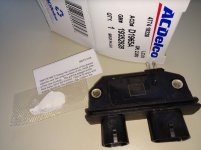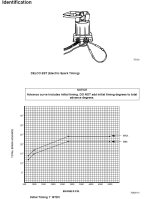centerline
Regular Contributor
I believe I am having a problem with my new distributor...
in my previous thread titled "older 4 cyl mercruiser identification", I had some great information to help me find out what this engine is, and then I outlined the problem I was having with the engine timing.
after double checking with the suggestions I received without finding the cause, I went into the engine to check the gears and cam for proper indexing.
I found the cam it was built with to be a re-ground cam, which normally shouldnt be a problem, and I dont know if this re-grind had anything at all to do with the cause of the problem, but as I had it apart, I purchased a new marine cam and lifters install in the engine, and then indexed it to insure it was correct.
then installed the engine back in the boat.
the other change that was made was to purchase an EST distributor to replace the old "points" distributor, as I questioned the mechanical advance curve that was in the old one... and now it seems to run great. it starts easy, it idles smooth and has great throttle response ( I havent taken it to the lake yet)....
but as im attempting to time the distributor according to the instructions in the manual (I believe im following the procedure correctly) there is no change happening when the white wires are connected vs disconnected from each other (neither in sound or timing marks) which, following the directions should allow me to time it at 1degree BTDC, and then after disconnecting the 2 white wires, it should automaticallyu advance itself to about 8BTDC.... and be good to go (after readjusting the carb)...
nothing happens whatsoever by connecting or disconnecting the white wires, or unplugging the timing device from the the distributor...
when power is applied to the black wire, and the white wires become disconnected, the engine dies, which I know is normal (black wire goes to shift assist circuit after modifying the shift assist circuit with battery + power)
does anyone have any suggestions as to where to problem may be with getting the timing to set correctly, either in my procedure or with the EST system?.... Thank you
in my previous thread titled "older 4 cyl mercruiser identification", I had some great information to help me find out what this engine is, and then I outlined the problem I was having with the engine timing.
after double checking with the suggestions I received without finding the cause, I went into the engine to check the gears and cam for proper indexing.
I found the cam it was built with to be a re-ground cam, which normally shouldnt be a problem, and I dont know if this re-grind had anything at all to do with the cause of the problem, but as I had it apart, I purchased a new marine cam and lifters install in the engine, and then indexed it to insure it was correct.
then installed the engine back in the boat.
the other change that was made was to purchase an EST distributor to replace the old "points" distributor, as I questioned the mechanical advance curve that was in the old one... and now it seems to run great. it starts easy, it idles smooth and has great throttle response ( I havent taken it to the lake yet)....
but as im attempting to time the distributor according to the instructions in the manual (I believe im following the procedure correctly) there is no change happening when the white wires are connected vs disconnected from each other (neither in sound or timing marks) which, following the directions should allow me to time it at 1degree BTDC, and then after disconnecting the 2 white wires, it should automaticallyu advance itself to about 8BTDC.... and be good to go (after readjusting the carb)...
nothing happens whatsoever by connecting or disconnecting the white wires, or unplugging the timing device from the the distributor...
when power is applied to the black wire, and the white wires become disconnected, the engine dies, which I know is normal (black wire goes to shift assist circuit after modifying the shift assist circuit with battery + power)
does anyone have any suggestions as to where to problem may be with getting the timing to set correctly, either in my procedure or with the EST system?.... Thank you
Last edited:




